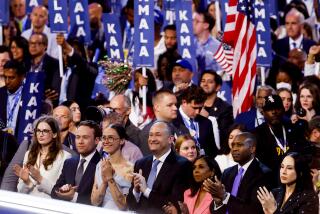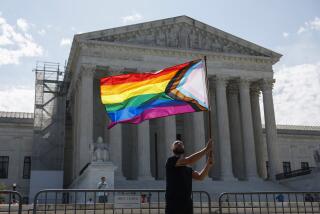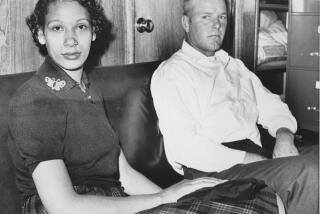Today’s Topic
- Share via
On April 2, 1968--two days before Dr. Martin Luther King, Jr. was assassinated in Memphis, Tenn.-- British pop star Petula Clark, during a television special aired on NBC, grasped the arm of her African-American guest, Harry Belafonte. The sponsor was outraged.
A few months later, on Nov. 22, the series “Star Trek” featured what was reported to be television’s first interracial kiss. Viewers never actually saw William Shatner (Capt. Kirk) buss Michelle Nichols (Lt. Uhura) but NBC threatened to pull the episode.
Today, mixed relationships are unremarkable media fare. Since television reflects popular culture, the increasing numbers of such real-life marriages comes as no surprise. Even the publicity glare on the Simpson murder trial has focused on domestic abuse, not interracial marriage.
The U.S. Census Bureau reports that there were only 310,000 interracial couples with white and African-American partners in 1972 compared to 1.2 million such couples in 1992. And a 1990 study found the intermarriage rate for Jews topped 50%.
“Intermarriage has gotten a lot easier because of the phenomenon of the shrinking world that is brought on by the tremendous improvement in mass communication and intercultural exchanges,” says Halford Fairchild, a professor of psychology and black studies at Pitzer College. “People are getting used to the idea. We see it more frequently.”
In today’s Platform, couples involved in interracial, intercultural and interethnic relationships discuss the challenges they face: coping with competing demands, a society that still isn’t fully accepting of their ties and imparting varying cultures to their children.
“Couples who intermarry must negotiate the differences between them,” says David Levy, a psychology professor at Pepperdine University: “They must learn to respect each other’s differences. That is a common theme in all marriages but in intermarriages the tensions tend to be heightened,” says Levy. “They really just magnify the same themes that almost every relationship has to struggle with--two people trying to live together.”
Still, there has always been a concern, especially within the Jewish and African-American communities, that intermarriage will dilute the religious or racial identity of these groups--and, in some cases, political clout as well-- by diminishing the number of people who identify themselves as being fully within a particular group. It’s the old argument about strength in numbers.
Adds Fairchild (who is himself a child of an interracial marriage): “There is going to be tension as certain ethnic enclaves seek to remain homogeneous. I think that is a legitimate orientation and perspective, particularly for discriminated-against minority groups. There is a political question when those numbers are reduced by people opting for a mixed marriage.” Yet, predicts Fairchild, “In another generation or two the whole world will be quite different. The melting-pot metaphor will begin to take hold.”
More to Read
Sign up for Essential California
The most important California stories and recommendations in your inbox every morning.
You may occasionally receive promotional content from the Los Angeles Times.













